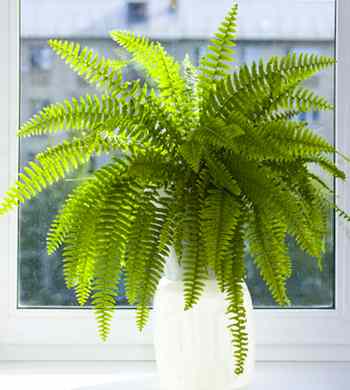By Sean Conway

When I bring my houseplants back inside after the better part of six months outdoors, it is like reconnecting with old friends. While placing them back in their winter locations inside our home, I take stock in how much they have grown, which ones need pruning and which ones need new pots.
Over the years, I have grown all sorts of houseplants, but lately I find myself gravitating to those that require the least amount of time to care for. Contrary to what you might think, the best low-maintenance plants tend to be those that need to be kept moist. The reason is simple: I am much more likely to be consistent with regular watering than with intermittent watering. Plants that like to dry out between waterings or plants that prefer to grow on the dry side require me to remember when they were watered last -- and, frankly, I have enough to remember as it is!
As long as the plants have proper drainage, removing the danger that they'll get waterlogged, I don't have to worry about overwatering them. It's a lot like making sure the dog's bowl has fresh water daily. I just water the plants as part of my routine. When plants require watering on an infrequent basis, it's much more likely I won't remember until the plant is either dropping its leaves or, worse, is completely dead.
Over the years, I have collected a diverse assortment of ferns, which seem to thrive on my routine watering schedule. I find ferns are not only easy to care for, with their preference for consistently moist soil, but they are also relatively pest free and have minimal need for fertilizer.
There are an estimated 12,000 species of ferns in the world, which grow in every climate where flowering plants are found. There are climbing ferns, tree ferns, aquatic ferns and epiphytic ferns, which spend their lives clinging to either trees or rocks.
Not only is there diversity in their growth habits but also in their frond shape, color and texture. While most of us think of ferns as being green plants (and many are), they can also be found with overlays of silver, red, pink and dusty white.
Most ferns grown as houseplants require a balanced potting soil that is slightly on the acidic side. The majority prefer to grow in bright light, while a few of the thicker-leaved rhizomatous types (often called rabbit's foot ferns) can tolerate direct sun while indoors during the winter months, provided they are kept evenly moist.
Ferns' ability to grow in low-light conditions makes them good choices for houseplants. They can live happily near a window rather than in it, offering more options for indoor placement.
I prefer to grow my ferns in clay pots, especially those on display in my home, but they will grow just as well in plastic pots.
A great way to conjure a fern's natural habitat is to display it in a log planter. A guest last season on my television show "Cultivating Life" showed me how to make beautiful pots out of fallen trees or branches. A log is cut into segments of whatever length you desire (make sure length and diameter of a log segment are such that it's able to stand on end stably). Next, the center of a segment is hollowed out using a drill with a Forstner bit. An empty plastic pot is placed inside.
Depending on whether you would like to use it to directly plant in or as a cachepot, holes can be drilled in the bottom of the log. The log planter will last longer if you line the hole with a plastic pot, which will protect the wood from moisture. An added protective layer of water sealing varnish can also be applied, which will also bring out the grain in the wood.
These planters easy to make, and any fern displayed in them will look right at home. To learn more, visit www.cultivatinglife.com and enter "Adirondack planters" into the search field.
Available at Amazon.com:
Trowel and Error: Over 700 Tips, Remedies and Shortcuts for the Gardener
Cut Your Energy Bills Now: 150 Smart Ways to Save Money & Make Your Home More Comfortable & Green
It's Easy Being Green: A Handbook for Earth-Friendly Living
Copyright © Cultivating Life by Sean Conway. All rights reserved.
AUTOS | HOBBIES | EDUCATION | FAMILY | FASHION | FOOD & RECIPES | HOME DECOR | RELATIONSHIPS | PARENTING | PETS | TRAVEL | WOMEN
Home & Garden - Key to Happy Houseplants: Low Maintenance